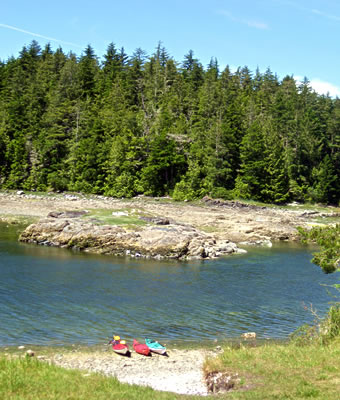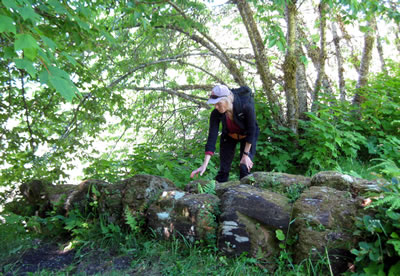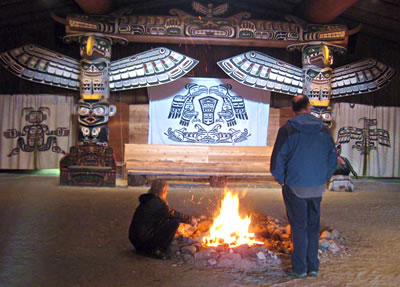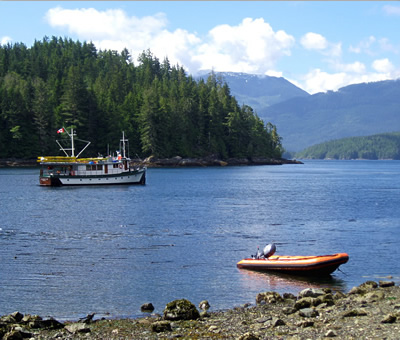Adventure Tours on Canada's Wild West Coast
Glimpses of an Indigenous Culture
Article and photos by Alison Gardner
Senior Travel Editor
|
|
|
Columbia III is a British Columbia Coastal vessel used by Mothership Adventures for multi-day nature and cultural tours.
|
I'm an extreme west coaster, born and bred, but Vancouver Island has a way of seeding its wilderness treasures among a myriad of illusive islands and ocean inlets that have taken a lifetime to discover. In my sixth decade, the northeast coast between cigar-shaped Vancouver Island and the British Columbia mainland is one area I'm still finding full of surprises. Driving on super paved roads 462 km/287 miles north from my home-base of Victoria to the village of Port McNeill, I was ready for something as yet untasted.
Studying a map of Canada's rugged Pacific Coast, it quickly becomes evident that these waters consist of a dense jumble of lily pad-like islands, perfectly sheltered stepping stones for explorations by small ships, zodiacs and even sea kayaks. Such slim waterways shepherd wildlife into concentrated corridors in which to witness up close the movements of many of the world's most remarkable marine mammals, birds and other sea life as they move between Alaska and warmer regions. Depending on individual migration seasons and a bit of luck, it is possible to observe within a few days dozens of whale species and killer whales (Orcas), and hundreds of porpoises, dolphins, sea lions and seals as well as bald eagles and other sea birds. And, of course, there are always those bears foraging for shellfish along the rocky beaches.

|
|
Islands around the northeast coast of Vancouver Island are safe sanctuaries for ocean kayaking and wilderness camping
|
Mothership Adventures caught my attention with a five-day small-ship cruise that combines an abundance of nature and rugged scenery with opportunities to learn about the rich Aboriginal history and present day culture. An Elder from the First Nations (native) community of Alert Bay cruised with our group, most of whom pretty well fit the definition of elder in their own right. All were adventure travelers with cultural and educational curiosity.
Under the ownership of husband and wife team, Ross and Fern Campbell, the classic wooden boat, Columbia III, is about as shipshape as any historical vessel could be. It started life in the mid-1950s as an Anglican Church missionary and medical relief ship serving isolated logging and fishing settlements on the BC coast. Following extensive restoration in the 1990s, the 68-foot/21-meter Columbia III is today an all-weather cruiser, retaining its rich hardwoods and polished brass in the public rooms and on deck, but completely updated with state-of-the-art kitchen, and ultra-modern navigational and safety systems. Cabins are small and basic, with either en-suite bathrooms or shared facilities, but virtually all waking shipboard time is spent in the cozy lounge and dining area, in the wheelhouse with Captain Ross, or on deck chatting with guests and crew over fresh organic coffee or a glass of wine.
On a small vessel with only 8 to 10 guests, the daily itinerary is very flexible, like the evening we heard from a fisherman over the ship's radio that some black and white Orcas were swimming south about an hour away. Though we had already tied up for the night at a government wharf, the skipper immediately cast off for an unscheduled evening cruise to watch a large male and four females feeding and socializing as the sun set over the water.
Led by knowledgeable elder, Lillian Hunt, the cultural threads of our shore excursions to now-deserted settlements and thriving First Nations communities offered a story of a colorful, proud, and sometimes tragic heritage. Before taking us ashore to explore any deserted, overgrown village site along the shoreline, Lillian announced that she had requested permission to take us there from an elder or chief originally from the village, a concept our own cultural norms would find quite unnecessary. This awareness somehow ensured that we trod carefully, identified as we were and hosted in someone else's land.
In surprisingly few decades, many of the more remote settlements from the first half of the 20th century are already being swallowed up by bush and rainforests of towering trees. Questioned why some elaborately carved totem poles could be abandoned to fall down and decay, Lillian assured us that practice is part of the natural lifecycle of any totem, according to her people. Traditionally, you don't restore or repaint the poles, you create new ones.

|
|
Tree-sized totem poles carved and painted by west coast native people are traditionally expected to fall in time and return to nature.
|
Conversations with Lillian during many delicious, hearty meals and during our twice daily excursions into the watery wilderness often included environmental life lessons applicable on a global scale. When the Columbia III tied up to village wharves, we visited outstanding First Nation museums showcasing both the heritage of many generations and the talented native artists today. In communities with a carved and painted ceremonial "Big House" decorated with iconic totem poles of the region, ancient dances and songs were graciously shared by three generations of costumed men, women and children demonstrating a revival of culture that was almost lost in the 20th century.

|
|
In village communities, native people pool their artistic and architectural talents to create their own ceremonial Big House for traditional dancing, feasting and story-telling.
|
Such close appreciation of unspoiled nature and the insights of a fragile traditional culture cannot be achieved on large ships with a large herd of guests. Such tours require the small scale of a Columbia III adventure where itineraries may be altered in pursuit of a special moment and lily pad islands offer many directions and those hoped-for surprises in a single day.
|
For More Info
The majority of Mothership Adventures' multi-day departures between late May and the end of September focus on nature observation and ocean kayaking. Columbia III is the kayaker "mothership". However, there are also several all-inclusive cruise tours for participants in search of a little less physical activity and a little more grassroots education. Cruise tours last four to five days and are each accompanied by a specialist in their field. From year to year, these may include a coastal history adventure, a photography tour, wilderness painting tours, and a First Nations cultural tour like the one described above.
At the native community of Alert Bay, the U'mista Cultural Centre houses an impressive collection of elaborately-carved masks, traditional and contemporary First Nations artifacts. CAD$8 for adults; $7 for seniors and students.
Visit the Tourism Vancouver Island website for vacation planning advice. At 460km/286mi in length and 100km/62mi in breadth, Vancouver Island is comparable in size to the Netherlands or Taiwan with a lot more wilderness and a lot less people! There are only 750,000 residents, half of which live in Greater Victoria on the southern tip of the island.
|
|




